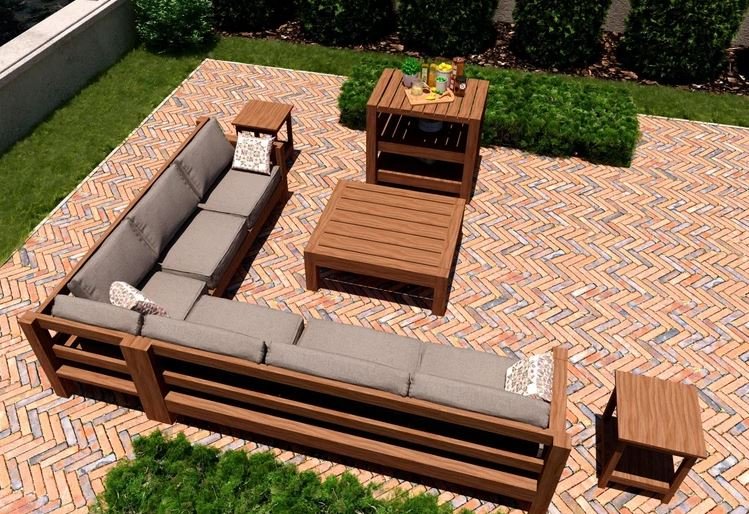How to Build a Sectional Furniture Set
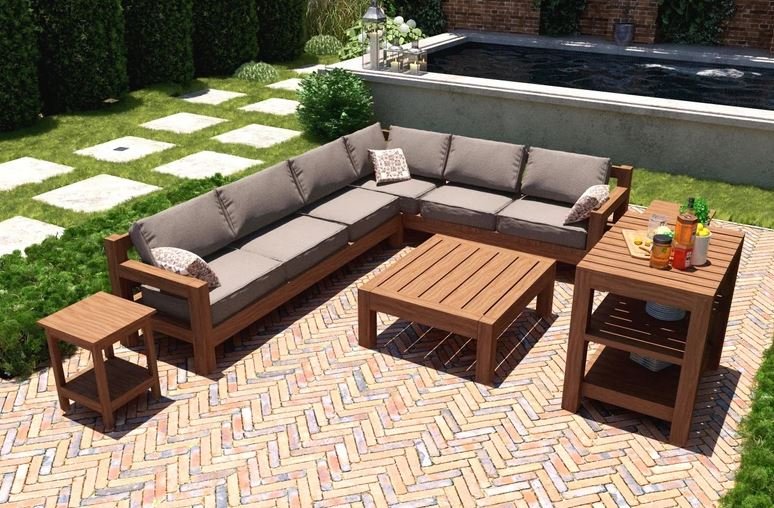
Note: All projects performed following instructions found on this site are done at your own risk. Learn more
The construction of this sectional sofa is simple. It has a beautiful style that suits your living space.
The screws we will use will provide durability.
Building this sectional sofa will be both funny and budget-friendly.
List of tools:
- Tape measure
- Saw
- Drill
- Nail gun
- Countersink drill bit
- Wood glue
- 1 1/2" thin wood screw, 2 1/4" thin wood screw, 2 1/2" thin wood screw, 5"desk screw, and 2 1/2" Kreg Jig screw
- Sanding
- air compressor
- Kreg Jig
Stain/preferred paint coating:
- Water-Based Pre-Stain Wood Conditioner
- Water-Based Wood Stain mixed: Desert Sand and Pure White
- Water-Based polyacrylic
Note: As an Amazon Associate, I earn from qualifying purchases.
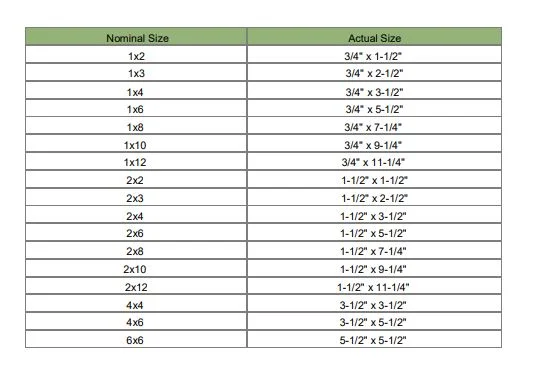
Cut List Sofa 1:
S1 - 1 – 4 x 4 x 24″ left front foot 2'
T1- 2 – 4 x 4 x 30″ right and left hind legs 5'
U1-U2 - 4 – 2 x 4 x 23 1/4″ mid supports between feet 7' 7''
V1 - 1 – 4 x 4 x 23 1/4″ left arm support 1' 11 1/4''
Y1 - 3 – 2 x 4 x 27 1/4″ panel supports of the right, left and middle parts 6' 9 3/4''
W1-W2- 4 - 2 x 4 x 89″ front and back middle support pieces between legs 29' 8''
XY1 - 4 - 2 x 4 x 89″ top boards 29' 8''
YZ1 - 2 - 2 x 4 x 89″ back support parts 14' 10''
X1 - 1 – 4 x 4 x 11 1/2″ right short forefoot 11 1/2''
Total: 2x4x88' 6 3/4'' , 4x4x9' 9 3/4''
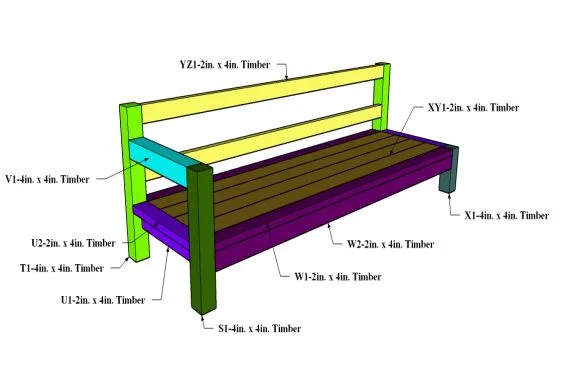
Cut List Sofa 2:
S1 - 1 – 4 x 4 x 24″ right front foot 2'
T1- 3 – 4 x 4 x 30″ right and left hind legs 7' 6''
U1-U2-U3-U4 6 – 2 x 4 x 23 1/4″ mid supports between feet, left part middle and upper supports 11' 7 1/2''
V1 - 1 – 4 x 4 x 23 1/4″ right arm support 1' 11 1/4''
Y1 - 3 – 2 x 4 x 27 1/4″ panel supports of the right, left and middle parts 6' 9 3/4''
W1-W2- 4 - 2 x 4 x 89″ front and back middle support pieces between legs 29' 8''
XY1 - 4 - 2 x 4 x 89″ top boards 29' 8''
YZ1 - 2 - 2 x 4 x 89″ back support parts 14' 10''
Total: 2x4x92' 7 1/4'' , 4x4x11' 5 1/4''
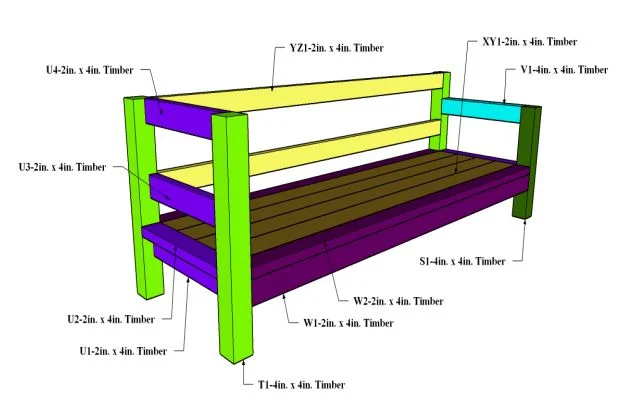
Cut List Bar Table:
F1 - 4 – 4 x 4 x 35″ foot 11' 8''
G1-G2-G3 6 – 2 x 4 x 20 1/2″ lower middle and upper supports between legs(side) 10' 3''
H1-H2 4 – 2 x 4 x 31 1/2″ lower and middle supports between legs (front and back) 10' 6''
I1-I2 18 – 1 x 4 x 23 1/2″ upper boards of lower and middle shelves 35' 3''
J1 - 2 – 2 x 4 x 31 1/2″ front and rear supports of the upper 5' 3''
Z1 - 10 – 1 x 4 x 27 1/2″ upper boards of lower and middle shelves 22' 11''
Total: 1 x 4 x 58' 2″ , 2x4x26' , 4x4x11' 8''
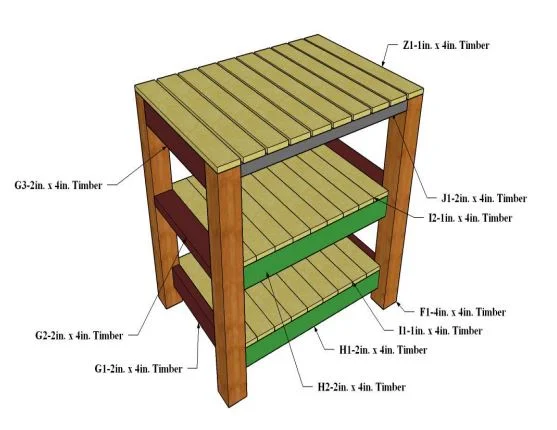
Cut List End Table:
A1 - 4 – 2 x 2 x 22″ legs 7' 4''
B1 4 – 2 x 3 x 13″ lower and upper front back supports 3' 6''
C1 4 – 2 x 3 x 12 1/2″ supports lower and upper right left 4' 2''
D1 5 – 2 x 3 x 13″ upper boards of the lower shelf 5' 5''
E1 - 5 – 1 x 4 x 18″ top boards 7' 6''
Total: 1 x 4 x 7' 6″ (x2) , 2x2x7' 4'' (x2) , 2x3x13' 8'' (x2)
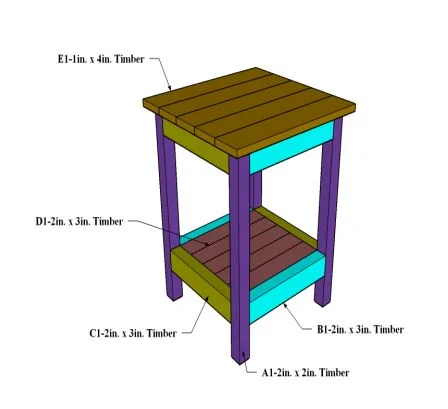
Cut List Coffee Table:
K1 - 4 – 4 x 4 x 16 1/2″ legs 5' 6''
L1 2 – 2 x 4 x 30″ upper part right and left supports 5'
M1 2 – 2 x 4 x 30″ right and left lower supports between the feet 5'
N1 2 – 2 x 4 x 36″ front and rear lower supports between legs 6'
P1 - 2 – 2 x 4 x 36″ front and rear upper supports between legs 6'
R1 - 5 – 2 x 6 x 36″ top boards 15'
Total: 2 x 4 x 22' , 2x6x15' , 4x4x5' 6''
Total lumber to be purchased from the store: 1x4x73' 2'', 2x2x14' 8'', 2x3x27' 4'', 2x4x229' 2'', 2x6x15', 4x4x38' 6''
If the end table is 1 piece: 1x4x65' 8'', 2x2x7' 4'', 2x3x13' 8'', 2x4x229' 2'', 2x6x15', 4x4x38' 6''
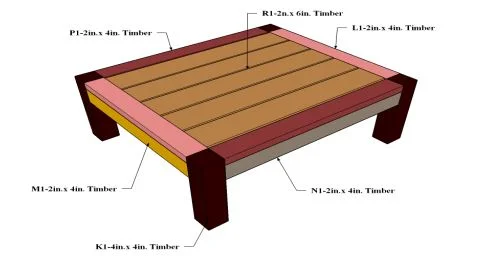
Wood painting information:
First, sand the wood with 150 grit or higher sandpaper to achieve a smooth, even surface before staining.
Thoroughly remove all dust from the wood by using a vacuum with a hose attachment, then wipe clean with a damp cloth.
Then wiping clean with a damp cloth. First, apply Pre-Stain Wood Conditioner to the boards.
Apply the Pre-Stain Wood Conditioner and allow it to penetrate the wood for just 1-5 minutes, then remove excess conditioner that has not soaked into the wood with a clean rag Apply Water Based Wood Stain to all of the wood.
You can the color Desert Sand mixed and the color Pure White mixed. What I love about the water-based stain is 1) how easy clean-up is… 2) how little odor the stain has… 3) the colors.
You can get everything from bold, colorful shades to neutral wood tones to light, creamy cottage and ocean-inspired stains.
Apply the stain using a foam brush, and allow it to penetrate the wood no longer than 3 minutes.
It is very fast-drying, so work in small sections! Wipe the wood with a clean cloth to remove any stain that has not soaked into the wood.
Allow the stain to dry 24 hours before applying a protective finish.
Tip: It will be easier to wear a pair of gloves while wiping the excess stain to keep our hands clean than to wash our hands.
After the stain has dried 24 hours, apply a thin coat of Water Based Polycrylic (I used the clear matte finish) using a brush.
Allow to dry at least 2 hours, then sand with a very fine 220 grit sandpaper and remove all dust.
Apply a second and third coat, drying and sanding in between each layer.
The wood will need 3 hours to dry before handling and 24 hours before it will be fully cured.
If you've ever used polyurethane on top of white paint and seen the yellow stains that appeared once the poly dried, you know how important it is to make sure you're using the right topcoat.
* If you wish, you can create different beautiful results with your own color choices. I prefer to use these colors mostly for coffee tables.
But beautiful colors will look good anywhere.
General Dimensions Sofa1:
Front View:
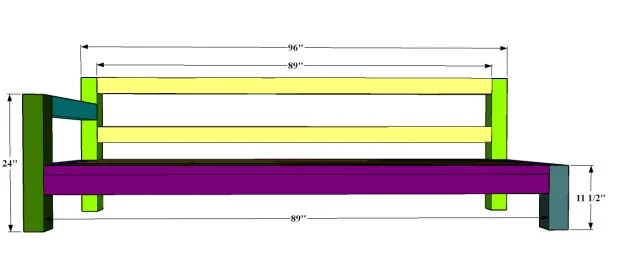
Right View:
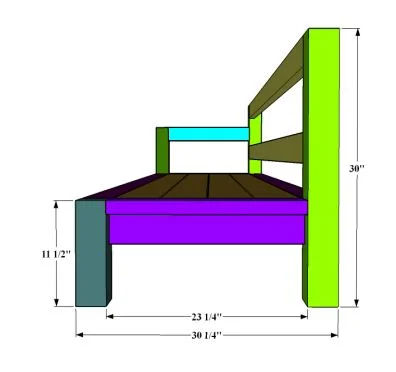
Left View:
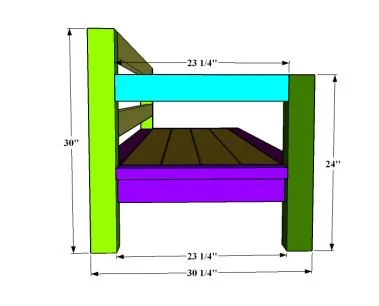
Top View:
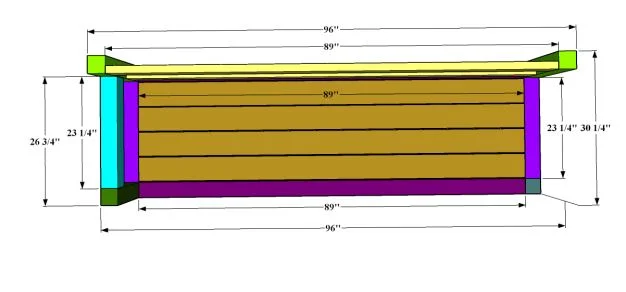
Back View:
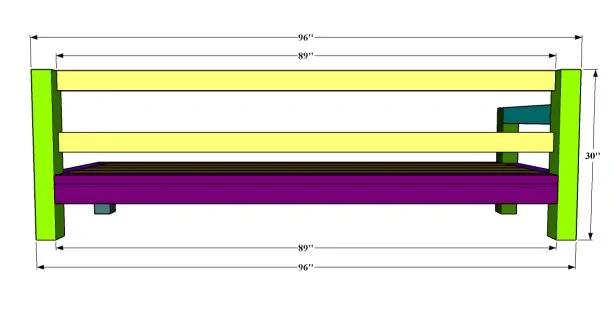
Bottom View:
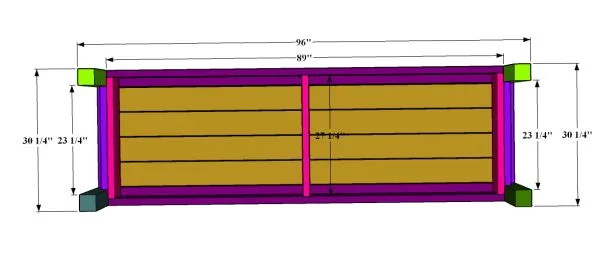
Assembly Process Sofa1:
Step 1:
First, we measure and mark a distance of 6.5'' from the bottom of the feet S1 and T1 to the top.
Then, just above the marked place, we stick the U1 piece, as in the picture, so that it coincides with the inside of the S1 foot.
After it dries, we stick the U2 piece on the joining surfaces by applying wood glue, so that it is horizontal just above the U1 piece.
Then we align and glue the arm support piece V1 to the top of the S1 foot.
After the parts are dry, we screw them in using 5'' screws from the outside of the S1 foot as in the 2nd picture.
Then, we align and glue the T1 foot to the ends of the U and V parts and screw it from the outside.
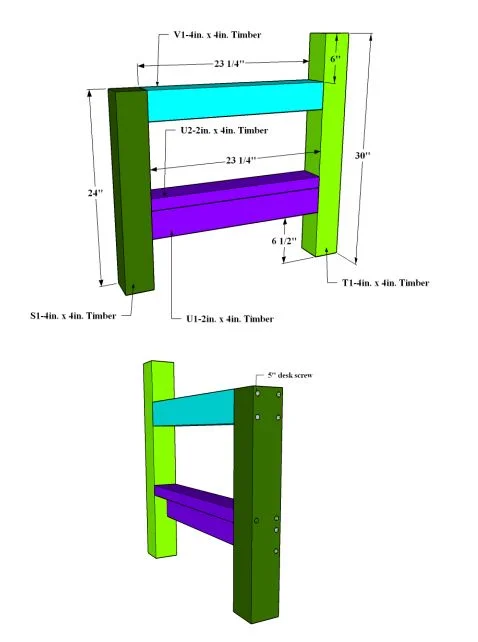
Step 2:
Now we glue the Y1 piece to the same level with the U1 piece, with a distance of 2'' from the right and left of the S1 and T1 legs.
After drying, we screw the Y1 piece to the S1, U1 and T1 parts.
You can increase the number of screws to make it stronger. Here we use 2 1/4" screws

Step 3:
Now, for the other foot parts, we measure and mark a distance of 6.5'' from the bottom up as in the previous process.
Then we glue the U1 and U2 pieces to the X1 piece Here part U1 must be aligned to the inside of part X1.
After it dries, we screw it in from the outside of the X1 foot using 5'' screws as in the picture.
Then we glue the T1 foot by aligning it to the end of the U1 and U2 parts and screw it in from the outside.
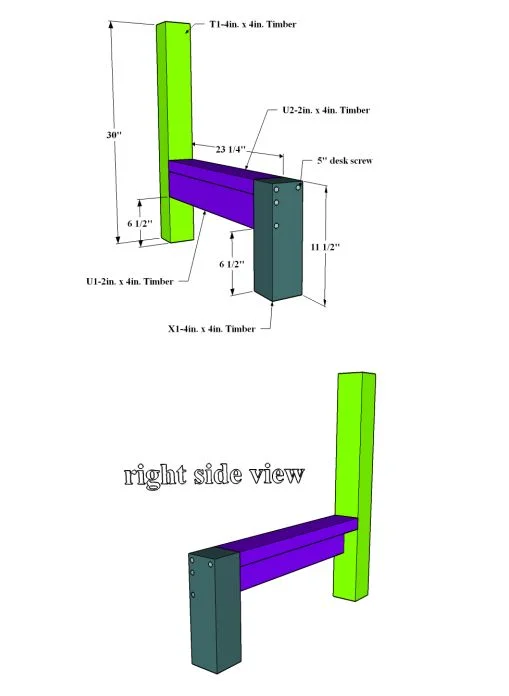
Step 4:
Now, as in the previous operation, we place the Y1 piece at a distance of 2'' to the left and right of the X1 and T1 feet.
Here we use 2 1/4" screws. It is important to do the screws as in the picture so that our sofa is stable.
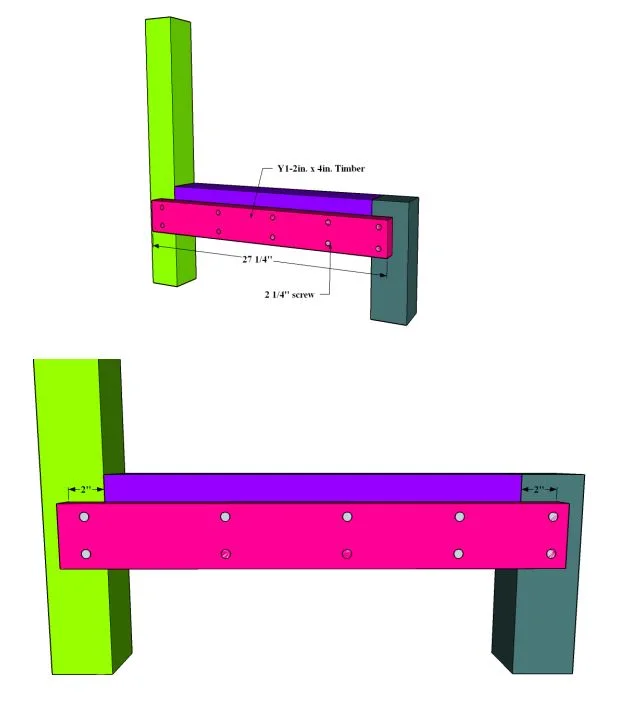
Step 5:
Now we glue the W1 pieces to the front and back ends of the Y1 piece as in the picture.
It will be easier to do this by resting the end of the W1 pieces against a 6.5'' high floor.
After it dries, we screw it using 2 1/4'' or longer screws.
If you started from the first left foot, then we glue the W1 piece with the tip of the Y1 piece on the other foot and screw it.
Now we measure and mark a distance of 42 1/4" from the right and left insides of the W1 parts to the middle.
We glue the third piece of Y1 to the middle part and screw it from both ends from the outside as in the picture.
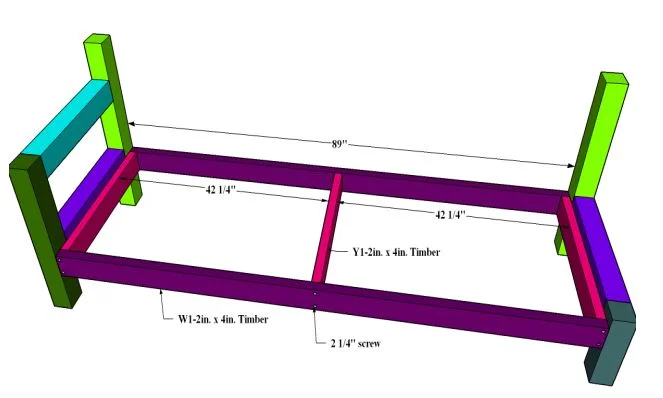
Step 6:
Now we place and glue the W2 pieces so that they align on top of the right and left W1 pieces.
We screw it from the right, left and middle parts to the lower parts as in the picture.
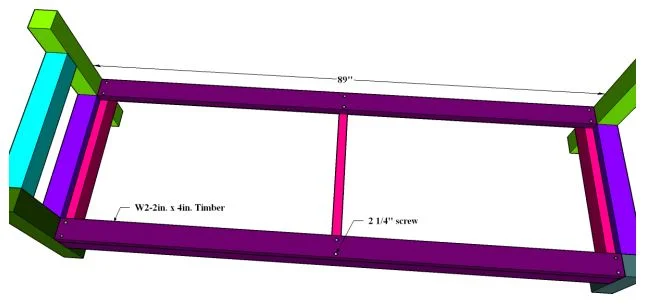
Step 7:
Now we place the XY1 boards next to the W2 boards with 1/4'' space between them.
We stick it to the contact surfaces with wood glue and after it dries, we screw it with 2 1/4'' screws from the top as in the picture.
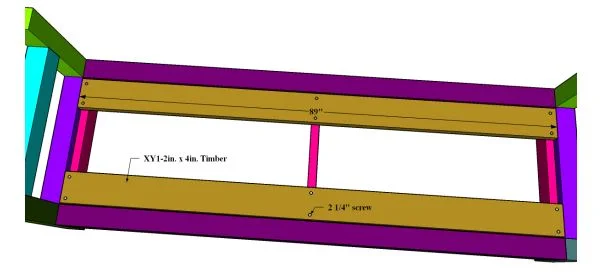
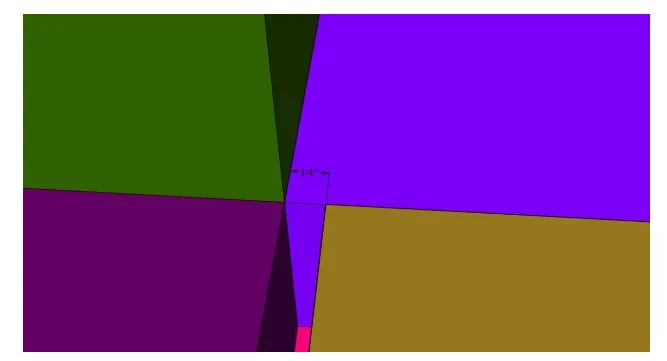
Then we place the other XY1 boards with 1/4'' space between them and screw them from the top as in the picture.

Step 8:
Now we glue the YZ1 piece so that it coincides with the upper inner part of the rear T1 legs.
Then we measure and mark 7 1/2'' distance down.
We paste the second YZ1 piece just below the part we marked.
After the wood glue dries, we screw it with 5'' screws from the outer parts as in the picture.
Here and in previous screwing processes, heating the screw for 3.4 seconds with a lighter will prevent the screw from damaging the wood.
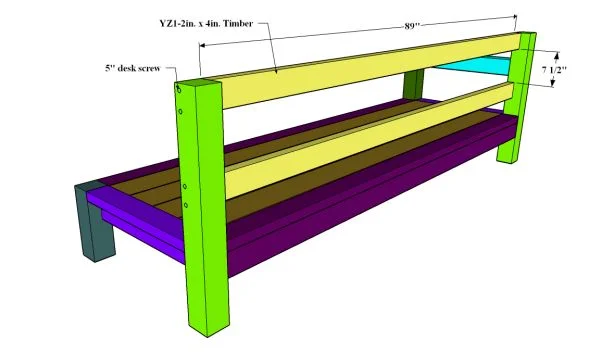
We completed our sofa1 project.
General Dimensions Sofa 2:
Front View:
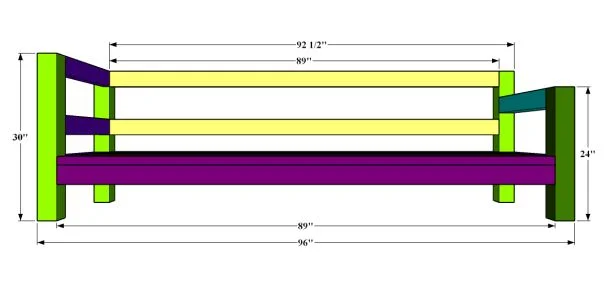
Right View:
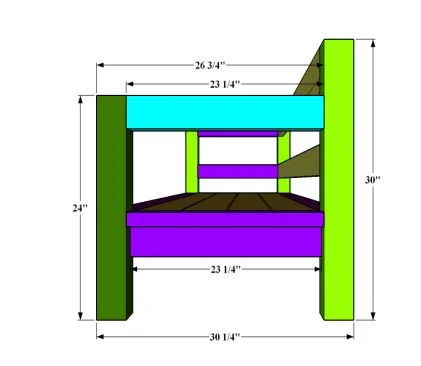
Left View:
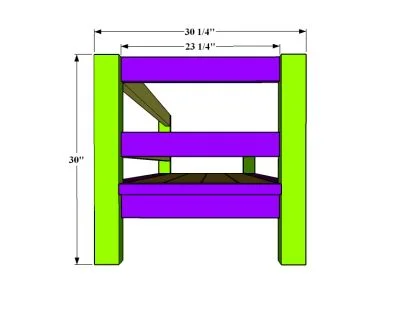
Top View:
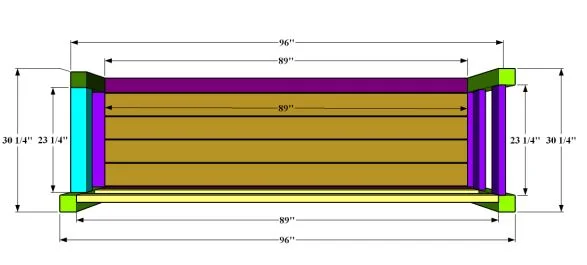
Back View:
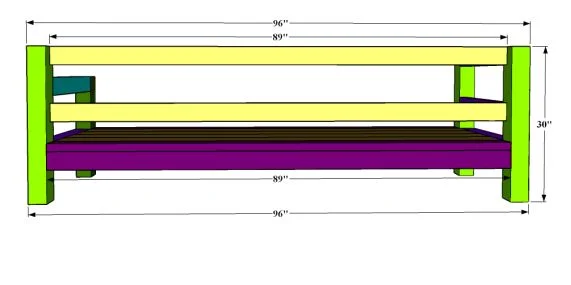
Bottom View:
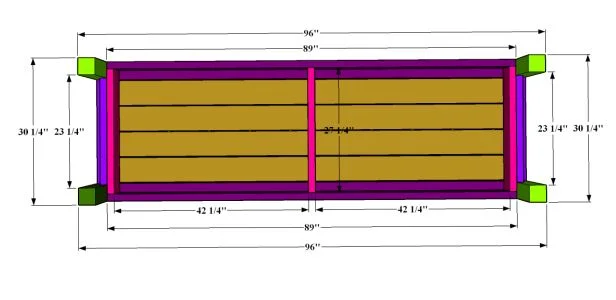
Assembly Process Sofa2:
Step 1:
First, we measure and mark a distance of 6.5'' from the bottom of the right and left T1 legs to the top.
Then, starting from the left or right foot, we stick the U1 piece vertically just above the marked place as in the picture.
Then we glue the U2 piece horizontally just above the U1 piece.
We wait for it to dry after applying wood glue to the T1 foot and the joining surfaces with U1.
Then, on the T1 leg, we measure and mark a 4'' distance upwards, starting just above the U1 part.
Then we stick the U3 piece just above the part we marked.
Then we stick the U4 piece vertically on the upper inner part of the T1 foot.
After all the parts are dry, we do the screwing operations using 5'' screws as seen in the picture.
Finally, after making sure that the feet are on the flat ground, we glue the other T1 foot to the end of the pieces and screw it from the outside.
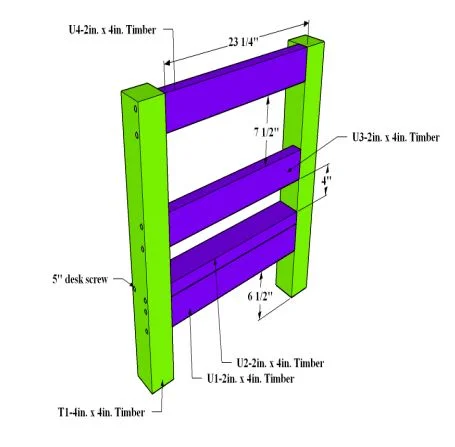
Step 2:
Now we glue the Y1 piece to the same level as the U1 piece, with a distance of 2'' from the right and left of the T1 legs.
After drying, we screw the Y1 piece to the U1 and T1 parts.
You can increase the number of screws to make it stronger. Here we use 2 1/4" screws.
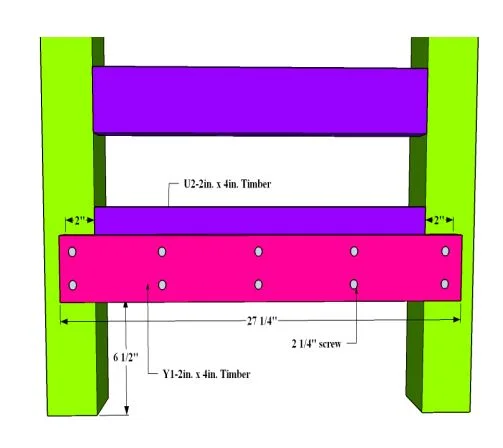
Step 3:
Now we measure and mark a distance of 6.5'' from the bottom of the parts S1 and T1 again to prepare the second legs.
Starting from the S1 foot, we stick the U1 piece vertically just above the marked place as in the picture.
After it dries, we glue the U2 piece horizontally on top of it.
Then, we glue the V1 arm support piece to the upper inner part of the S1 leg and screw it from the outside.
Here we use 5'' screws. We stick the other T1 foot to the end of V1 and U1,U2 and screw it from the outside.
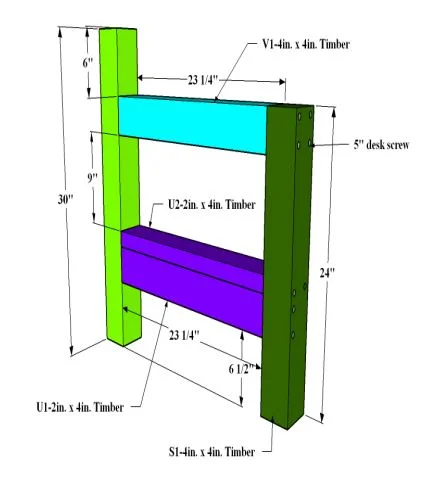
Step 4:
Now, as in the previous operation, we place the Y1 piece at a distance of 2'' to the left and right of the S1 and T1 feet.
Here we use 2 1/4" screws.
It is important to do the screws as in the picture so that our sofa is stable.
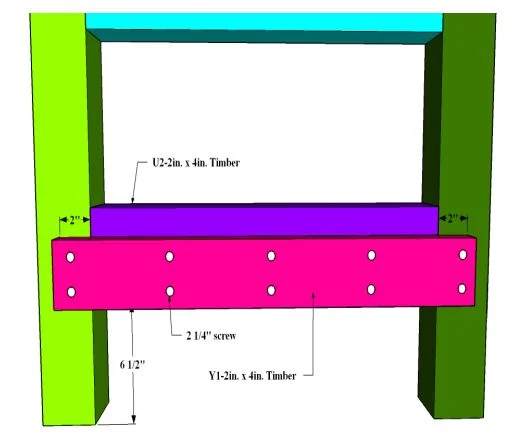
Step 5:
Now we glue the W1 pieces to the front and back ends of the Y1 piece as in the picture.
It will be easier to do this by resting the end of the W1 pieces against a 6.5'' high floor. We screw it using 2 1/4'' or longer screws.
If you started from the first left foot, then we glue the W1 piece with the tip of the Y1 piece on the other foot and screw it.
Now we measure and mark a distance of 42 1/4" from the right and left insides of the W1 parts to the middle.
We glue the third piece of Y1 to the middle part and screw it from both ends from the outside as in the picture.
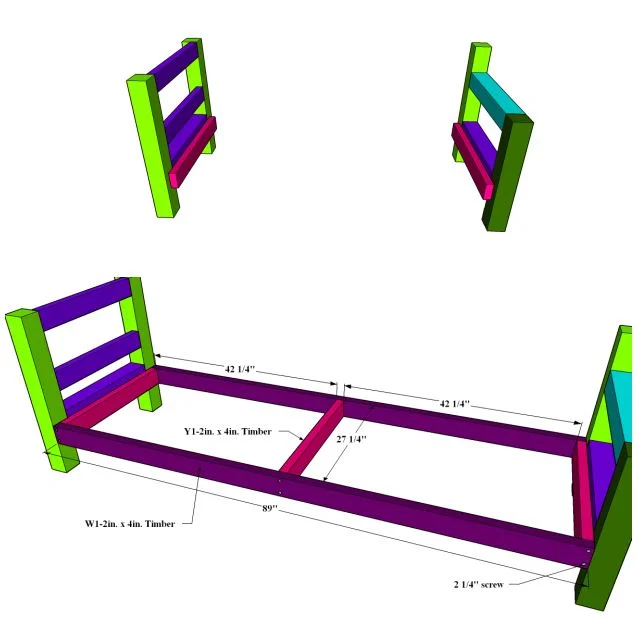
Step 6:
Now we place and glue the W2 pieces so that they align on top of the right and left W1 pieces.
We screw it from the right, left and middle parts to the lower parts as in the picture.
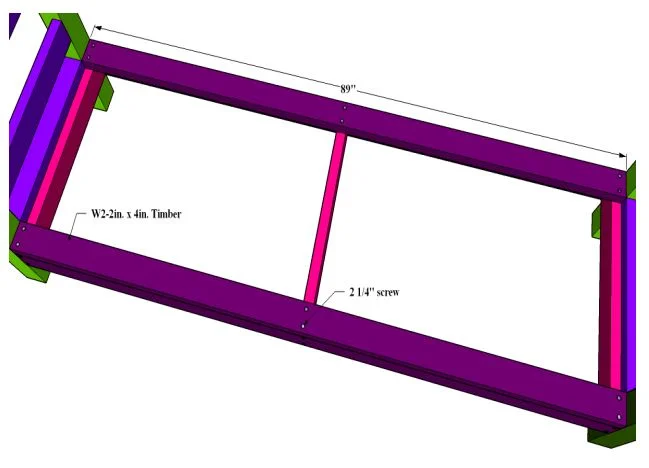
Step 7:
Now we place the XY1 boards next to the W2 boards with 1/4'' space between them.
We stick it to the contact surfaces with wood glue, we screw it with 2 1/4'' screws from the top as in the picture.
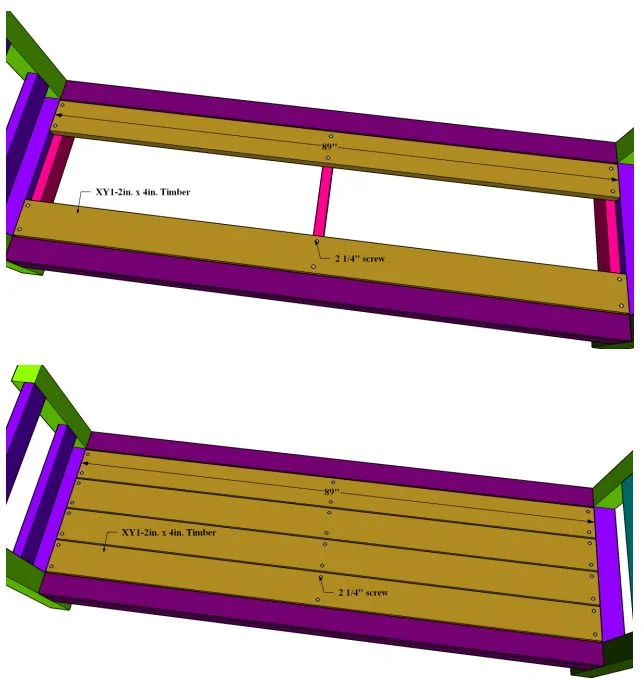
Then we place the other XY1 boards with 1/4'' space between them and screw them from the top as in the picture.
Step 8:
Now we glue the YZ1 piece so that it coincides with the upper inner part of the rear T1 legs.
Then we measure and mark 7 1/2'' distance down.
We paste the second YZ1 piece just below the part we marked.
After the wood glue dries, we screw it with 5'' screws from the outer parts as in the picture.
Here and in previous screwing processes, heating the screw for 3-4 seconds with a lighter will prevent the screw from damaging the wood.
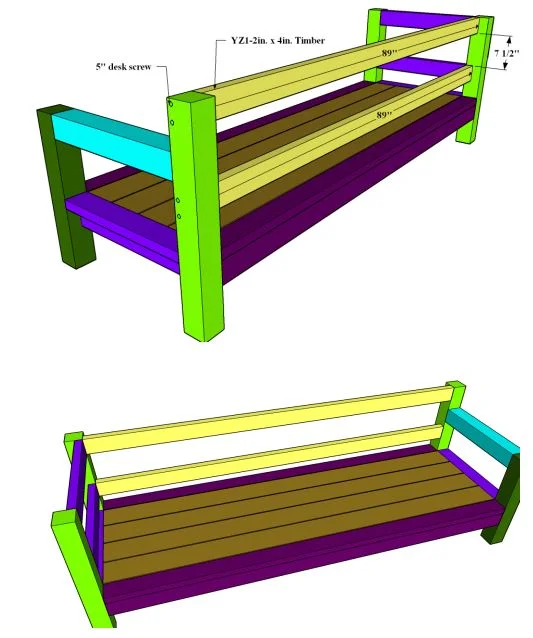
We completed our sofa 2 project.
General Dimensions Bar Table:
Front View:
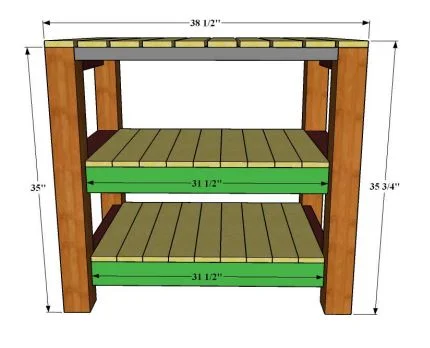
Side View:
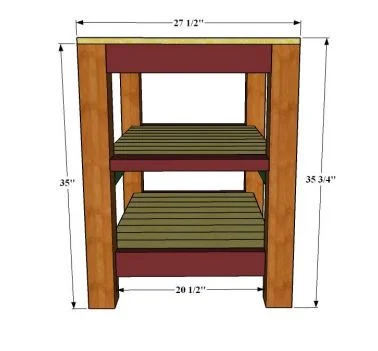
Top View:

Bottom View:
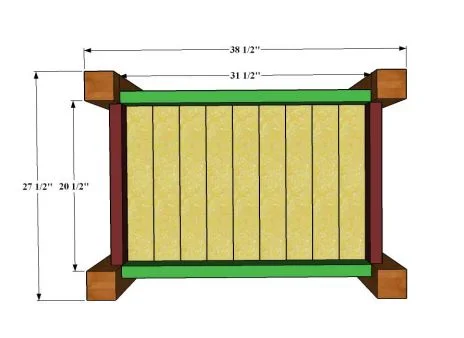
Assembly Process Bar Table:
Step 1:
First, we measure and mark 3 3/4 inches from the bottom of the F1 legs to the top.
Then we stick the first G1 piece vertically on the inside of an F1 leg, just above the marked place, as in the picture, and screw it from the outside.
Then we measure and mark 11 3/4'' from just above the 1st piece of G1 upwards.
Then, just above the marked place, we glue the 2nd G1 piece horizontally as in the picture and screw it from the outside.
Then we glue and screw the 3rd piece of G1 on the upper part of the F1 foot so that it is aligned with its outer side.
Then we stick the 2nd foot on the end of the G1 parts and screw it from the outside. In this type of screwing, after heating the screws for 3-4 seconds with the help of a lighter, screwing them in will prevent the screws from damaging the wood.
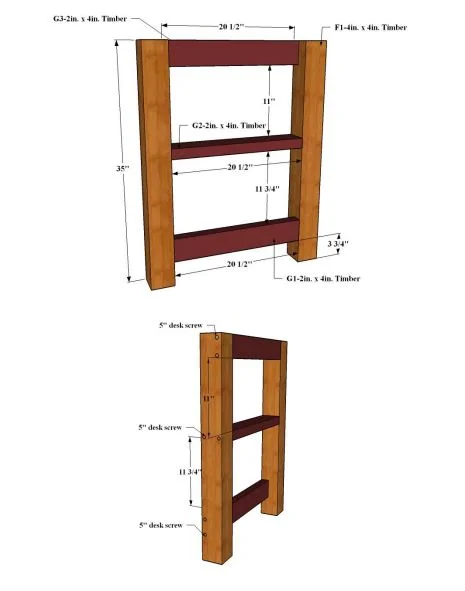
If you wish, if you have a Kreg Jig apparatus, you can adjust the apparatus according to 1 1/2'' wood and drill two pocket holes on the right and left ends of the G1 pieces.
Then you can screw the G1 pieces to the F1 feet in sequence using 2 1/2'' Kreg Jig screws.
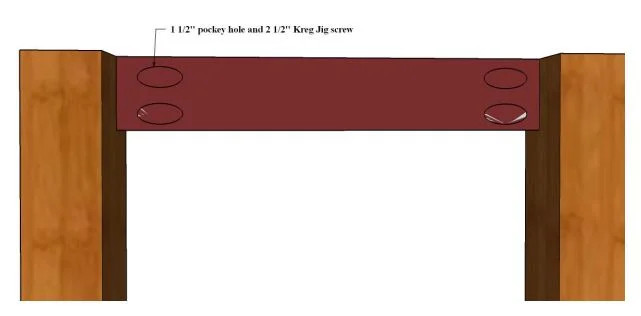
Now, we repeat these operations once again for the opposite legs and make the 2nd legs ready.
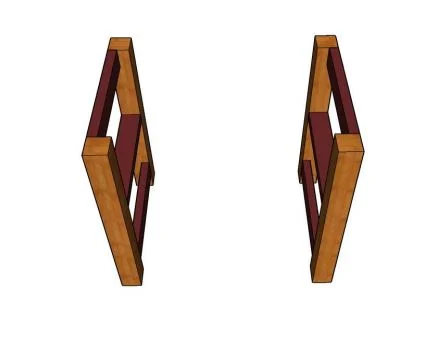
Step 2:
Now we measure and mark 3'' from the bottom of the F1 legs upwards. There will be 3/4'' distance between it and the G1 part.
Now, we adjust the Kreg Jig apparatus according to 1 1/2'' wood and make pocket holes on the right and left ends of the H1 piece.
Then we paste the H1 parts just above the part we marked. Then we screw it in using 2 1/2'' Kreg Jig screws.
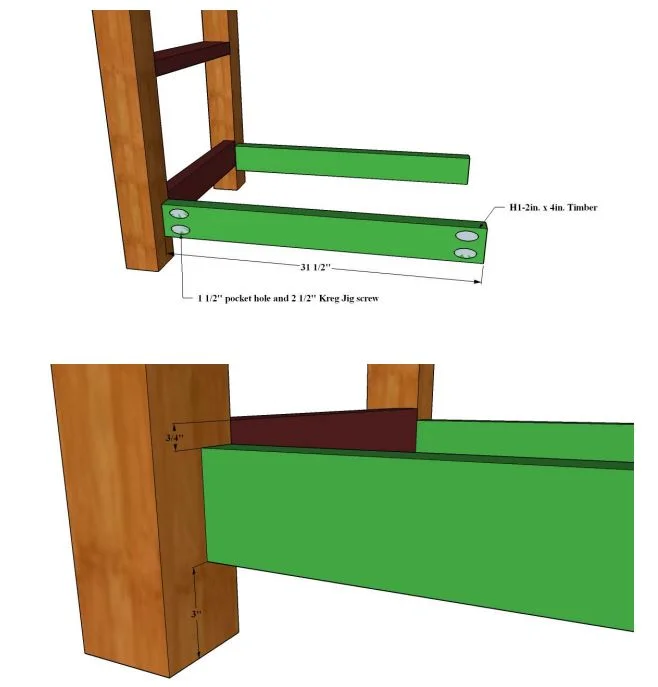
Step 3:
Now we measure and mark 3'' from the bottom of the 2nd legs that we prepared before.
Then we align and glue the H1 pieces just above the marked place and screw them with a 2 1/2" Kreg Jig screw.

Step 4:
Now, we place and glue the I1 boards adjacent to each other so that they coincide exactly with the front and rear ends of the H1 parts.
Then we screw it to the lower H1 parts using 1 1/2'' screws from the front and rear ends.
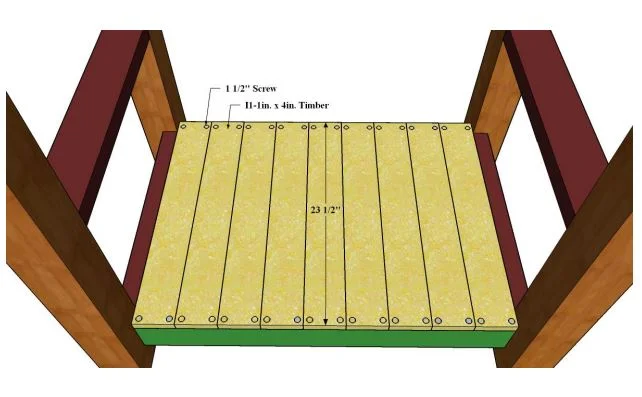
Step 5:
Now, as in the previous step, we drill 1 1/2'' pocket holes on the right and left ends of the H2 pieces.
Then we measure and mark 3/4'' down from the G1 parts in the middle and glue the H2 parts just below the marked part.
Then we screw the H2 parts to the F1 legs using 2 1/2'' Kreg Jig screws

Step 6:
Now we glue the I2 boards adjacent to each other so that they exactly coincide with the front and rear ends of the H2 pieces.
Then we screw it with 1 1/2'' screws from the front and rear ends to coincide with the H2 parts
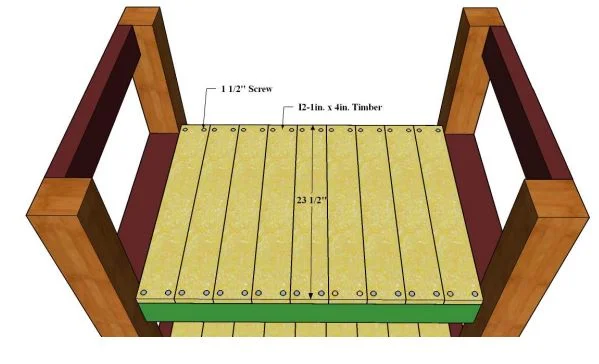
Step 7:
Now we place the J1 pieces horizontally on the upper ends of the F1 legs and glue them. Then, if you want, you can screw it from the outside of the F1 feet as in the picture.
If you want, you can drill 1 1/2'' pocket holes on the right and left ends of the J1 pieces as in the previous process and screw them using 2 1/2'' Kreg Jig screws.

Step 8:
Finally, we place the Z1 pieces starting from the right or left edge with 3/8'' space between them and screw them with 1 1/2'' screws from the front and rear ends.
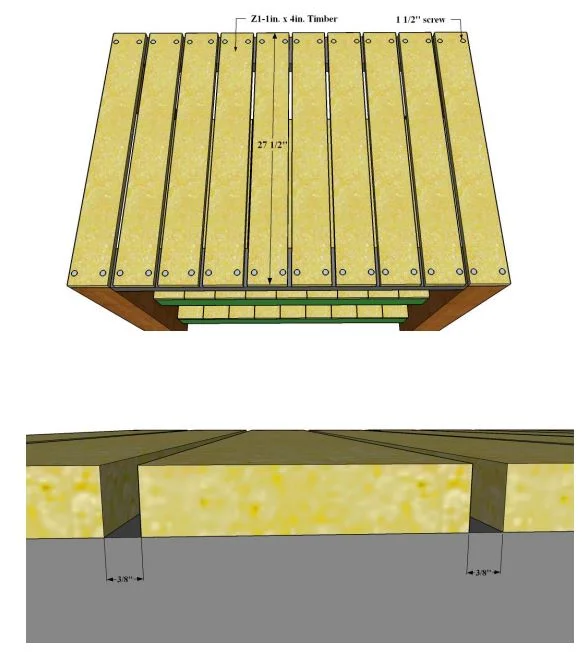
We completed our bar table project.
End Table Dimensions
Side View:
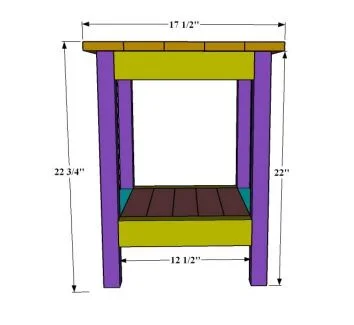
Front View:
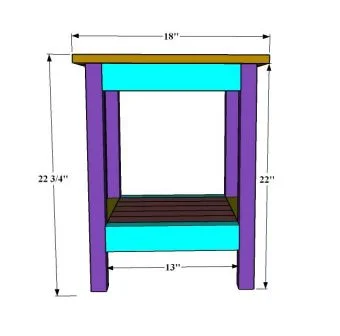
Front View:
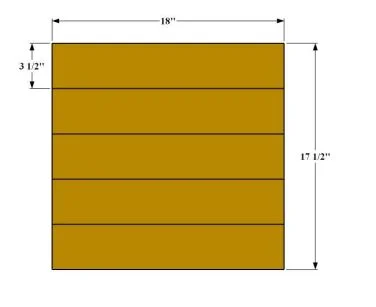
Top View:
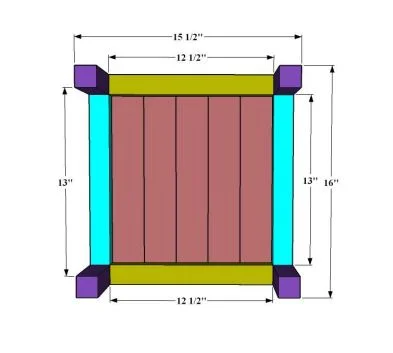
Assembly Process End Table:
Step 1:
First, we measure and mark a distance of 4 inches from the bottom of the A1 foot upwards.
Then we stick one of the B1 lower support pieces just above the part we marked and screw it on.
We glue and screw the other B1 support piece so that it coincides with the top of the A1 foot.
While doing the screwing process, we need to make two screws one after the other so that they coincide with the upper part of the B1 part.
We will make the other support pieces in the opposite way of the current screwing. It will be sufficient to use 2 1/2" screws here.
If you have, you can use any screw that is not smaller than this size.
Since we will use these operations on the opposite side, we repeat once again and we have prepared the other legs.
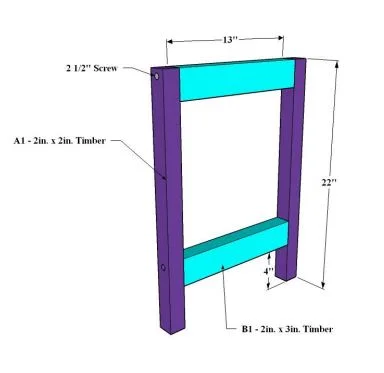
Step 2:
Now we glue and screw the C1 support pieces to the front of the A1 feet in line with the B1 pieces.
When screwing, you need to be careful that the screws do not overlap with other screws. Again we use 2 1/2" screws.
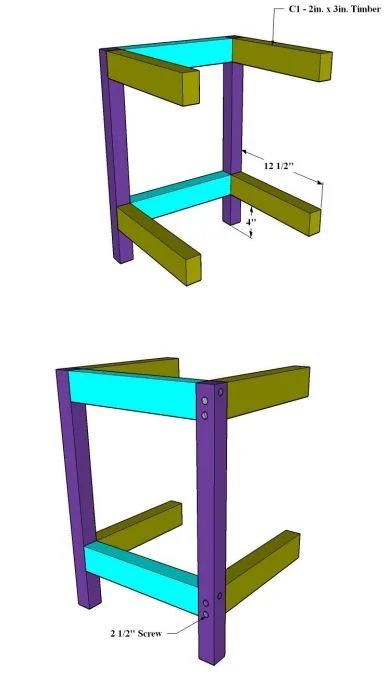
Step 3:
Now we glue and screw the opposite feet that we completed in the first stage on the ends of the C1 lower and upper support parts.
While doing the screwing process, we make sure that it does not overlap with the other screws. Again we use 2 1/2" screws.
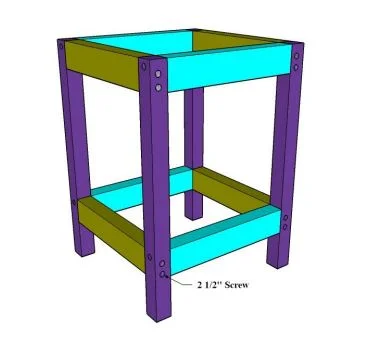
Step 4:
Now we glue the D1 sub-boards between the C1 parts, starting from the right or left, and screw them in from the front and rear ends. 2 1/2" screws will suffice.
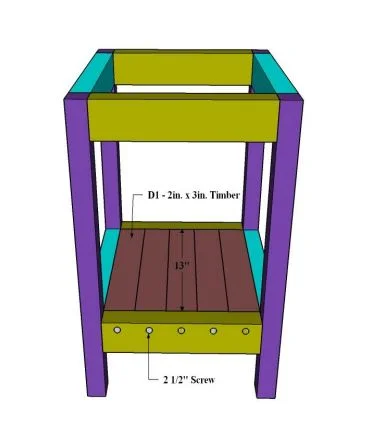
Step 4:
Now, we place the E1 top boards on the right and left sides, leaving 1 inch from the front and rear ends, and 1 inch from the right and left sides, and screw them over.
Here you need to use 1 1/2'' screws. You can adjust it appropriately so that the screws at the ends do not coincide with the bottom screws.
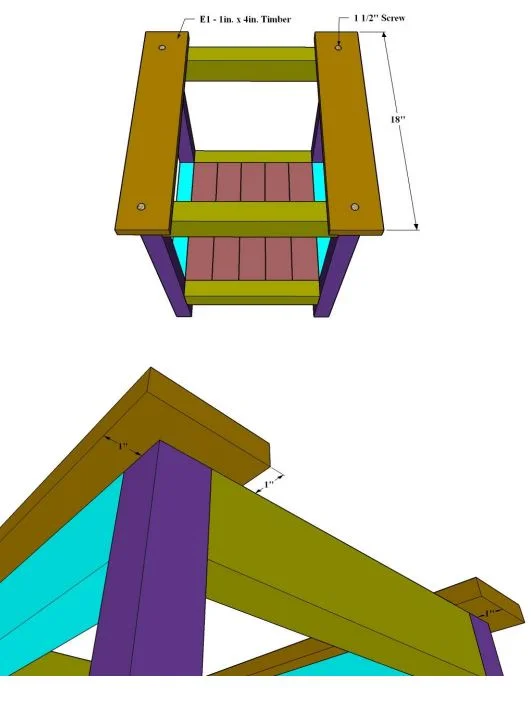
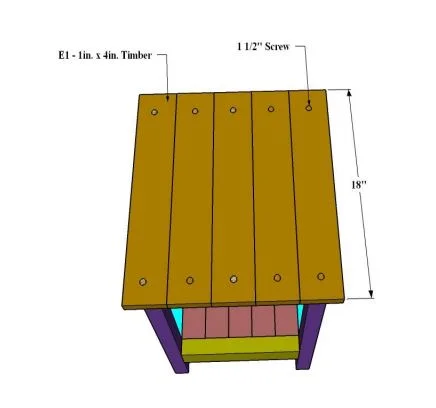
We have completed our End Table project!
Coffee Table General Dimensions
Side View:
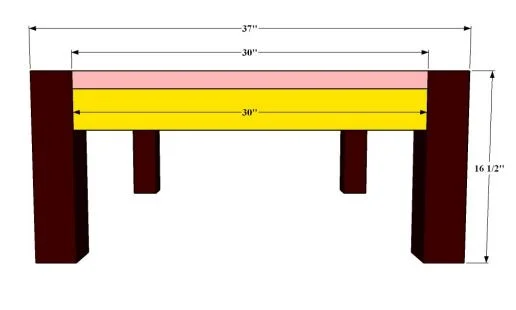
Front View:
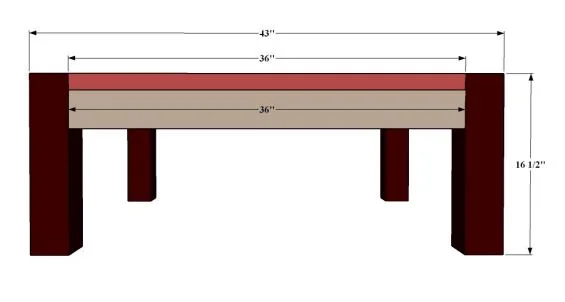
Top View:

Bottom View:

Assembly Process Coffee Table:
Step 1:
First, we glue the L1 middle support piece, as in the picture, so that it exactly coincides with the upper inner part of the K1 foot.
After it dries, we make 2 screws on the outer right and left sides of the K1 foot. We use 5'' screws.
In the next step, it is necessary to screw the screws of the L1 part slightly down or slightly up so that we do not have problems when screwing the P1 side support part.
We do this screwing in the same way for the M1 part. Now we place the M1 part on the lower outer part of the L1 part as in the figure and paste it on both K1 and L1 parts.
Then we screw the M1 part from the outward side of the K1 foot so that it coincides with the lower and upper points.
We repeat these operations one more time to use on the opposite side and we prepare the other legs.
Here, we should pay attention to the fact that the M1 middle support part comes to the inside of the K1 legs.
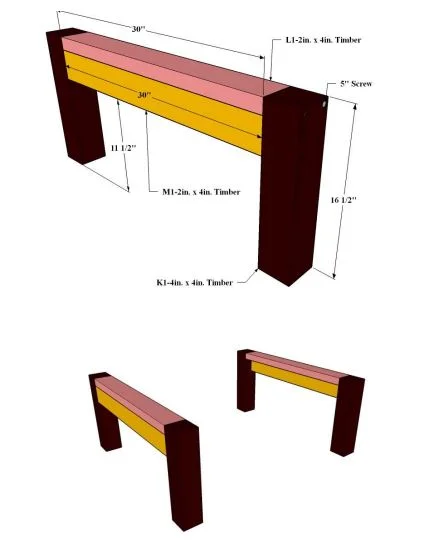
Step 2:
Now, we stick the P1 side support pieces as shown below so that they exactly coincide with the upper side of the K1 legs.
After the wood glue dries, we screw it from the outside of the K1 feet.
We need to screw the L1 part a little down or up in the opposite direction of the direction we screwed.
Then we place the N1 lower side support piece so that it coincides with the outer and lower part of the P1 piece and glue it to both the K1 piece and the P1 piece.
We adjust the screwing of the N1 part according to the type of screwing in the previous stage, and we make it either from the middle part close to each other or from the lower and upper parts.
It will also be sufficient to screw the P1 parts to the N1 parts from the top.
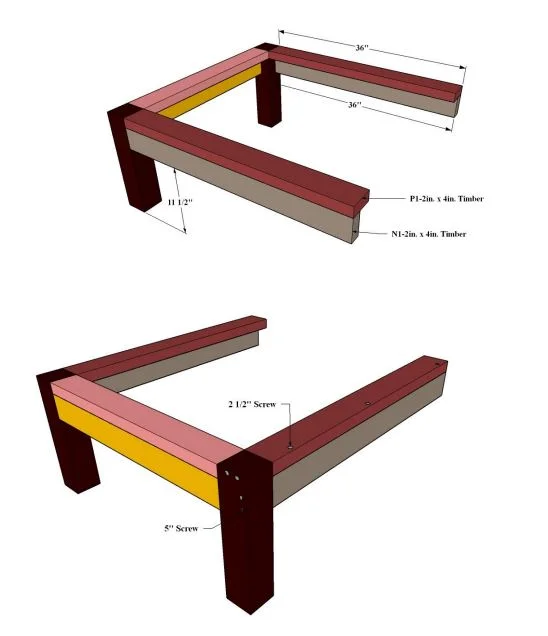
Step 3:
Now, we stick the R1 top boards to the L1 piece starting from the right or left comb with a 13/32'' (0.41inch) gap between them and screw them from the outside after it dries.
You can make 3 screws to be more solid. For vertical screwing, you need to use 5'' thin screws.
If you wish, you can adjust your Kreg Jig apparatus according to 1 1/2'' wood and drill pocket holes from the front and rear ends of the R1 pieces and screw them using 2 1/2'' Kreg Jig screws.
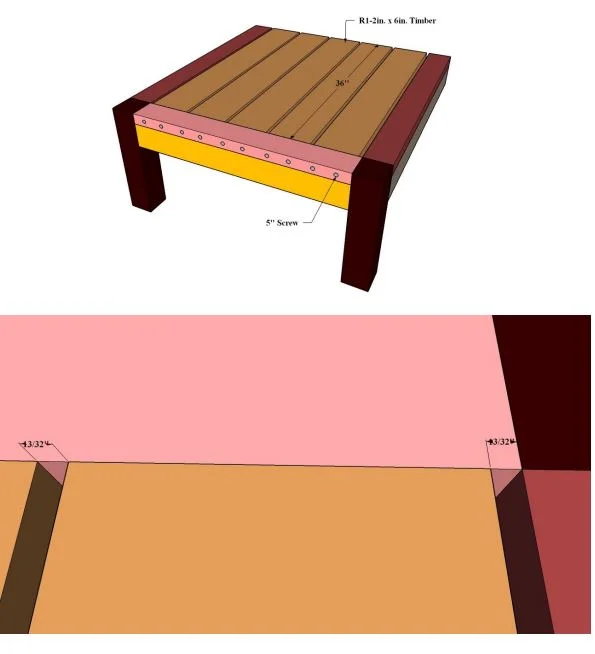
Step 4:
Now we glue the opposite legs that we made in the 1st stage to the ends of these joints. It will be easier to do this on a flat surface.
As seen in the picture below, we need to adjust the screwing operations so that they do not touch each other. Since our area is large, this will not be a problem.
Because we use 2x4 timbers for even the smallest double screwing area.
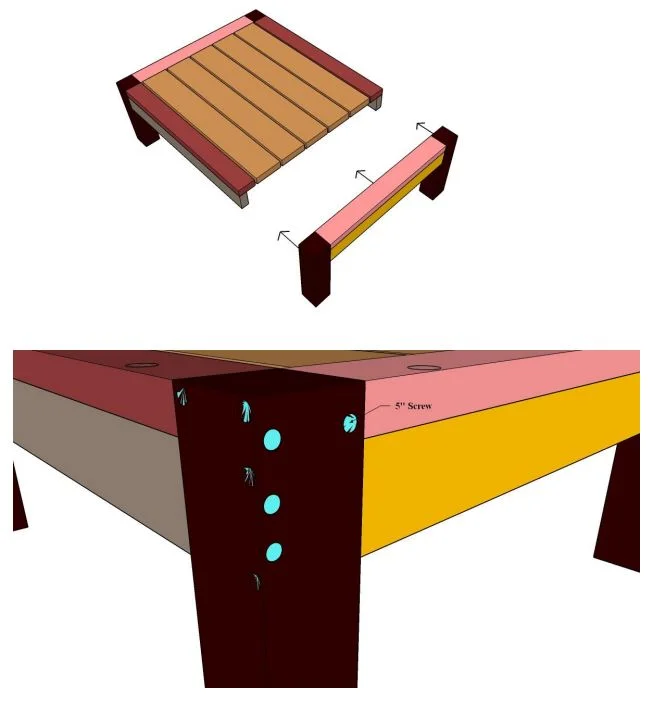
Step 5:
After combining the opposite legs and completing their screwing, we can make it more solid by screwing the upper parts of our coffee table if you want.
We used 5'' normal screws for all screwing operations.
For screwing from the top, 2 1/2'' screws will be sufficient. After all the screwing processes are completed, we can fill the screw holes to make our coffee table look more beautiful.
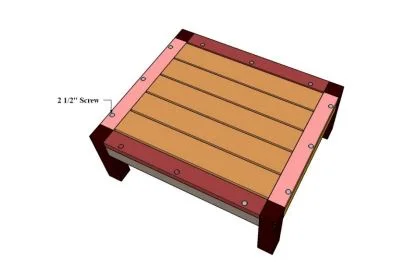
Thus, we completed our Coffee Table project!
This patio furniture set not only will make plenty of rustic charm to your backyard and outdoors depending on your design preferences but also, will look modern, minimalistic, warm, and relaxing in your farmhouses.

